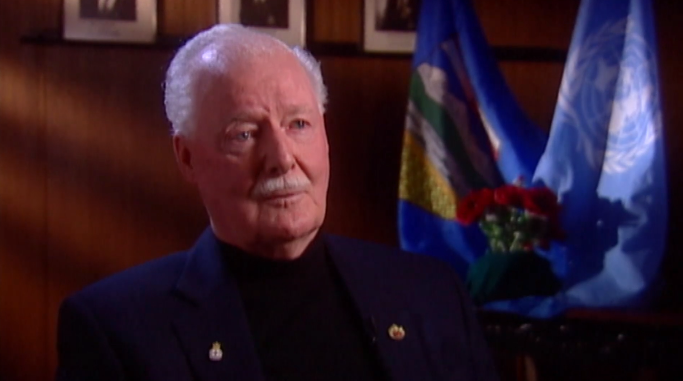Well I had . . . I really had one of the most unusual
experiences, that a, that a, I don't think there's anyone else
had it and survived. And we were, we were coming back on a raid
one time, and it was, most of our stuff was done at night,
as you know, and the Americans did the daylight raids
and we did the night stuff.
And we were on our way back and my engineer, he was standing
right beside me and he is always checking things and so on and,
and he looked out at the wingtip and this was at night,
of course you couldn't see very far but, he said,
he said "Look skip." I'd take a look and
there's a Fortress flying, an American Fortress on my wing tip,
in formation with me like, just like this.
And he was only about two wingspans away and I could see
the outline of the aircraft, that tail section you can't miss it.
What happened was, that this was obviously a Fortress that had
force landed, had been shot up, in the daylight raid and
got into a field without doing too much damage.
I, for some reason had a funny feeling about this,
so my mid upper gunner, I said "Larry swing your guns
on that fella and just keep your eye on him.
There's something funny here". So he was there,
I suppose a minute and I said to myself, "Well listen,
I guess he's on our group and so I'll slow down
to give him a break". So I just pulled the power off a bit,
and so, so when you do that, its like 2 cars on the road,
you put the brakes on, this car goes ahead.
Well he came ahead, he got up about there and then turned across
and opened up the gunners and stuff came right through the nose
of the aircraft and I just yelled instinctively "Look out!"
and, and pulled back on the aircraft. My bomb aimer,
his name was McKinnon, ol' Mac, we called him, of course,
and he was sitting, and they sit on a bench,
there right behind me, and, and Mac just pulled the curtain
because they got her, we don't, no lights of course, of any kind,
and he, he pulled the curtain and stood up and the cannon shell
hit him, hit his foot right there, just tore his foot off
and dumped him. He went right down into the bomb aimer
compartment and ripped off his oxygen mask, of course,
and I'm in, by this time I'm in about this position and finally
got the aircraft squared away again and back on course and now
of course we're, we thought this is,
this has got to be a pretty stupid guy flying that aircraft that
couldn't recognize a, a Lancaster,
if I can recognize his aircraft. But anyway 2 days,
I'm back in my office and, and the intelligence officer called me
and said "Can I come down to see you,
I got something to show you?" and I said, "Sure.".
So he come down and walked in and said
"You know this, as you call him this stupid American pilot that,
that shot at ya?" and he said, he said, "It wasn't, it was a,
it was a Fortress with a rogue crew" and I said,
"Explain that." So he said, "It's a German crew
on board the aircraft." They put it, got it serviceable again
and repaired it and so on and they slipped in
on the bomber stream. Now I don't know how,
when he was beside me he could have just blown me out of the air,
but I think what he was worried about,
because maybe he had this experience before,
if he took out my two port engines on, on the burst,
where he is right here on my level, then the aircraft,
I wouldn't be able to control it quickly enough.
We'd go, slam into him you see, so he wanted to get up
in a safer position, before they opened fire.
And, so as I say, we survived, we, we just lucky
that Mac was the only one hit.
Interviewer: What do you think contributes
to you being here today, that's a pretty close call?
Yeah, that was.. I think that it was the fact that
I said to Larry put your guns on this guy. So here we were,
he had his on me of course and they thought boy all he has to do
is do that and we're going to get, get it. So I think that when..
and Larry followed him as, as I slowed down, you see,
so we wanted to get up to where the point Larry would
have to fire, he can't fire though the props.
The gun, your mid upper gunners guns, go up like this around
the prop you see, if he continued turning the turret,
so he knew what he was doing.
Interviewer: Pretty close call.
But that was, we had a sweat about that one afterwards,
when we heard the news, when I told the guys what had happened.
He says "My god." Larry said, our, my mid upper said,
"My gosh it was lucky you said to swing my,
I wouldn't have done it, I'd be just watching him".



